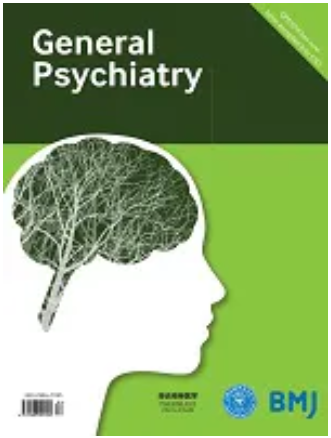周期性间歇θ脉冲刺激对阿尔茨海默病的影响
IF 5.3
3区 医学
Q1 PSYCHIATRY
引用次数: 0
摘要
背景 以前的研究表明,兴奋性重复经颅磁刺激(rTMS)可以改善阿尔茨海默病患者(AD)的认知功能。间歇θ脉冲刺激(iTBS)是一种新型的兴奋性经颅磁刺激方案,用于刺激大脑活动,具有诱导类似长期电位可塑性的能力,是一种治疗阿尔茨海默病的有效方法。然而,iTBS对AD患者认知能力下降和大脑结构的长期影响尚不清楚。目的 我们旨在探讨每三个月重复加速 iTBS 是否能减缓 AD 患者的认知能力衰退。方法 在这项随机、评估者盲法对照试验中,每13周对42名AD患者的左侧背外侧前额叶皮层(DLPFC)进行为期14天的iTBS治疗。测量包括蒙特利尔认知评估(MoCA)、综合神经心理测试和海马灰质体积(GMV)。对患者进行了基线和随访评估。SPM 计算解剖工具箱的纵向管道用于检测治疗相关的显著变化。结果 iTBS组相对于对照组保持了MoCA评分(t=3.26,p=0.013),并减少了海马萎缩,而海马萎缩与整体退化量表的变化显著相关。基线迷你精神状态检查(MMSE)评分、载脂蛋白E基因型和临床痴呆评级对随访时的MoCA评分具有指示作用。此外,活跃组左侧(t=0.08,p=0.996)和右侧(t=0.19,p=0.977)海马的 GMV 保持不变,而对照组则显著下降(左侧:t=4.13,p<0.001;右侧:t=5.31,p<0.001)。在整个干预过程中,左侧(r=0.35,p=0.023)和右侧(r=0.36,p=0.021)海马的GMV变化与MoCA变化呈正相关;左侧海马GMV变化与整体退化量表(r=-0.32,p=0.041)变化呈负相关。结论 DLPFC-iTBS可能是一种可行且易于实施的非药物干预方法,可减缓AD患者整体认知能力和生活质量的逐渐下降,为AD治疗提供了一种新的选择。试验注册号[NCT04754152][1]。如有合理要求,可提供相关数据。支持该试验结果的数据可向相应作者索取。[1]:/lookup/external-ref?link_type=CLINTRIALGOV&access_num=NCT04754152&atom=%2Fgpsych%2F37%2F1%2Fe101106.atom本文章由计算机程序翻译,如有差异,请以英文原文为准。
Effects of a periodic intermittent theta burst stimulation in Alzheimer’s disease
Background Previous studies have demonstrated that excitatory repetitive transcranial magnetic stimulation (rTMS) can improve the cognitive function of patients with Alzheimer’s disease (AD). Intermittent theta burst stimulation (iTBS) is a novel excitatory rTMS protocol for brain activity stimulation with the ability to induce long-term potentiation-like plasticity and represents a promising treatment for AD. However, the long-term effects of iTBS on cognitive decline and brain structure in patients with AD are unknown. Aims We aimed to explore whether repeating accelerated iTBS every three months could slow down the cognitive decline in patients with AD. Methods In this randomised, assessor-blinded, controlled trial, iTBS was administered to the left dorsolateral prefrontal cortex (DLPFC) of 42 patients with AD for 14 days every 13 weeks. Measurements included the Montreal Cognitive Assessment (MoCA), a comprehensive neuropsychological battery, and the grey matter volume (GMV) of the hippocampus. Patients were evaluated at baseline and after follow-up. The longitudinal pipeline of the Computational Anatomy Toolbox for SPM was used to detect significant treatment-related changes over time. Results The iTBS group maintained MoCA scores relative to the control group (t=3.26, p=0.013) and reduced hippocampal atrophy, which was significantly correlated with global degeneration scale changes. The baseline Mini-Mental State Examination (MMSE) score, apolipoprotein E genotype and Clinical Dementia Rating were indicative of MoCA scores at follow-up. Moreover, the GMV of the left (t=0.08, p=0.996) and right (t=0.19, p=0.977) hippocampus were maintained in the active group but significantly declined in the control group (left: t=4.13, p<0.001; right: t=5.31, p < 0.001). GMV change in the left (r=0.35, p=0.023) and right (r=0.36, p=0.021) hippocampus across the intervention positively correlated with MoCA changes; left hippocampal GMV change was negatively correlated with global degeneration scale (r=−0.32, p=0.041) changes. Conclusions DLPFC-iTBS may be a feasible and easy-to-implement non-pharmacological intervention to slow down the progressive decline of overall cognition and quality of life in patients with AD, providing a new AD treatment option. Trial registration number [NCT04754152][1]. Data are available on reasonable request. The data supporting the findings of this trial are accessible on request from the corresponding authors. [1]: /lookup/external-ref?link_type=CLINTRIALGOV&access_num=NCT04754152&atom=%2Fgpsych%2F37%2F1%2Fe101106.atom
求助全文
通过发布文献求助,成功后即可免费获取论文全文。
去求助
来源期刊

General Psychiatry
医学-精神病学
CiteScore
21.90
自引率
2.50%
发文量
848
期刊介绍:
General Psychiatry (GPSYCH), an open-access journal established in 1959, has been a pioneer in disseminating leading psychiatry research. Addressing a global audience of psychiatrists and mental health professionals, the journal covers diverse topics and publishes original research, systematic reviews, meta-analyses, forums on topical issues, case reports, research methods in psychiatry, and a distinctive section on 'Biostatistics in Psychiatry'. The scope includes original articles on basic research, clinical research, community-based studies, and ecological studies, encompassing a broad spectrum of psychiatric interests.
 求助内容:
求助内容: 应助结果提醒方式:
应助结果提醒方式:


